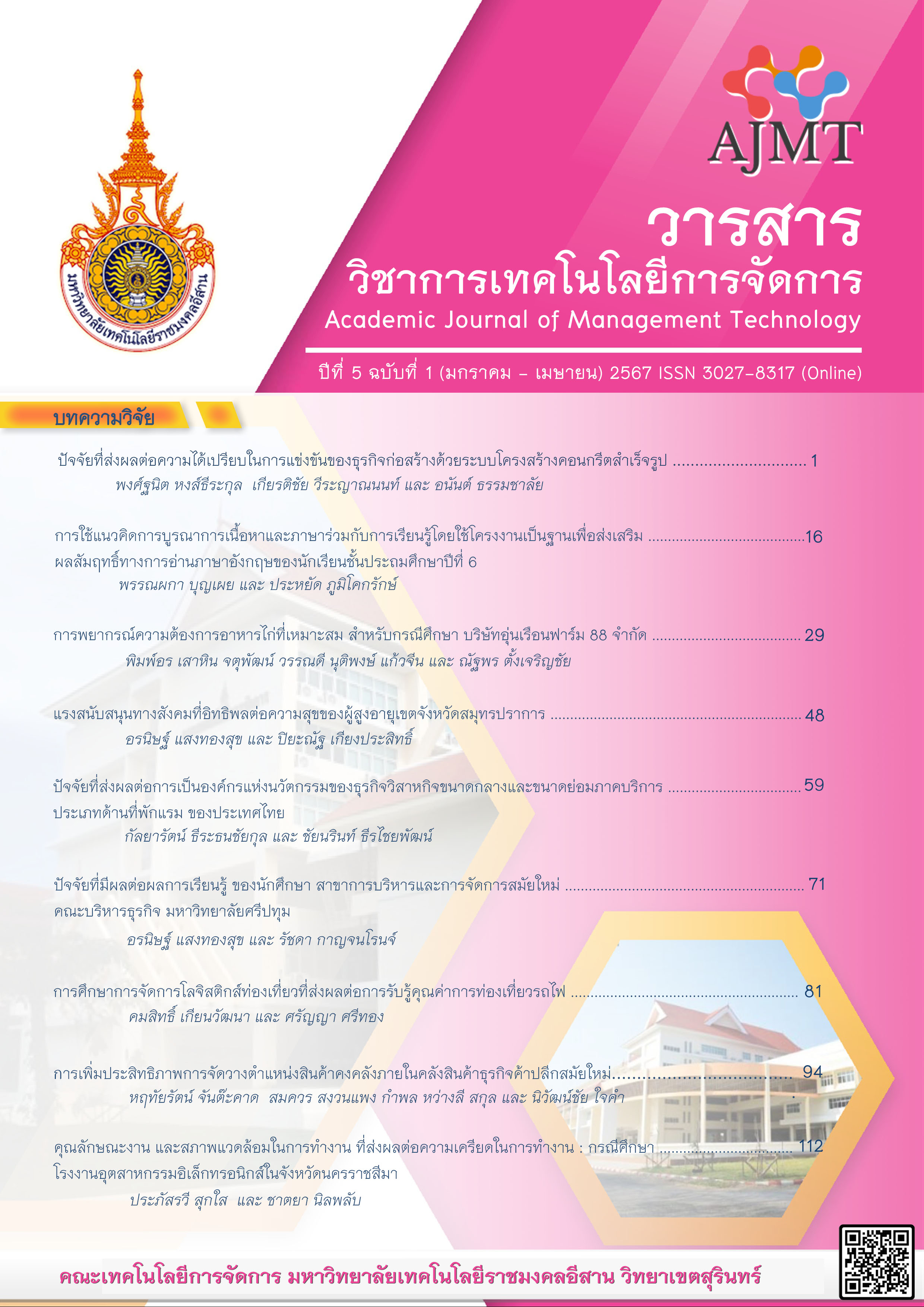การพยากรณ์ความต้องการอาหารไก่ที่เหมาะสม สำหรับกรณีศึกษา บริษัทอุ่นเรือนฟาร์ม 88 จำกัด
DOI:
https://doi.org/10.14456/ajmt.2024.3คำสำคัญ:
การพยากรณ์ , วันจับไก่ , อาหารไก่บทคัดย่อ
งานวิจัยนี้มีวัตถุประสงค์ในการหาค่าการพยากรณ์ที่เหมาะสมกับอาหารไก่ทั้ง 3 เบอร์ และทำการพยากรณ์ระยะวันเวลาในการจับไก่ โดยการประยุกต์ใช้วิธีการพยากรณ์ทั้ง 4 รูปแบบ ประกอบด้วย 1) การพยากรณ์แบบค่าเฉลี่ยเคลื่อนที่ (Moving Average) 2) การพยากรณ์แบบเอกซ์โปเนนเชียล (Single Exponential Smoothing) 3) การพยากรณ์โดย วิธีสมการแนวโน้มเส้นตรง (Linear Trend Equations Method) และ 4) การพยากรณ์โดยวิธีสมการแนวโน้มกำลังสอง(Quadratic Trend Equations Method) การวิเคราะห์ข้อมูลในงานวิจัยในครั้งนี้ได้ใช้โปรแกรมสำเร็จรูป (Minitab 18)นำข้อมูลที่ได้มาทำการทดสอบวิธีการพยากรณ์ที่เหมาะสมจากเกณฑ์ที่ใช้ในการเปรียบเทียบ คือ ค่าเฉลี่ยความเบี่ยงเบนสมบูรณ์ (Mean Absolute Deviation : MAD) ค่าเฉลี่ยความผิดพลาดกำลังสอง (Mean Squared Error : MSE) และค่าร้อยละความคลาดเคลื่อนสมบูรณ์เฉลี่ย (Mean Absolute Percentage Error : MAPE) ที่มีค่าต่ำที่สุด ผลจากงานวิจัยพบว่า อาหารไก่เบอร์ 511 อาหารไก่เบอร์ 513 และช่วงเวลากำหนดวันจับไก่ มีวิธีการที่เหมาะสมในการพยากรณ์โดยวิธีสมการแนวโน้มกำลังสอง (Quadratic Trend Equations Method) ที่ให้ค่าความแม่นยำในการนำค่าไปเทียบกับปริมาณการบริโภคอาหารไก่จริงในรุ่นที่ 10 คิดเป็นร้อยละเฉลี่ยเท่ากับ 98.21 ซึ่งจะมีเพียงอาหารไก่เบอร์ 510 ที่มีความเหมาะสมกับวิธีการพยากรณ์แบบเอ็กโปแนนเชียล (Single Exponential Smoothing) ที่ให้ค่าความแม่นยำในการนำค่าไปเทียบกับปริมาณการบริโภคอาหารไก่จริงในรุ่นที่ 10 คิดเป็นร้อยละ 92.99 จากการวิเคราะห์วิธีการพยากรณ์ในรูปแบบต่าง ๆ จะเห็นได้ว่าข้อมูลส่วนมากที่ให้ค่าความคลาดเคลื่อนต่ำที่สุดจะเป็นในส่วนของการพยากรณ์โดยวิธีสมการแนวโน้มกำลังสอง (Quadratic Trend Equations Method)
เอกสารอ้างอิง
Atiprayoon, N., Thongthirapap, A., & Chaipitak, S. (2020). Comparison of forecasting methods for time series with non-linear and non-stationary characteristics. Journal of Science and Technology, 28(2), 197-207.
Bureau of Commodity Trade Department of International Trade Negotiations. (2022). Chicken meat and products. https://www.dtn.go.th/th/file/get/file/1.20220401b13d85e0b079b00bffc227a7e327b460091515.pdf
Kasaraphong, P., Klanngen, C., Luesak, K., & Chaisuwan, T. (2023). Controlling the medical supply inventory by determining the appropriate amount of medical supply disbursement according to the annual budget using a spreadsheet, case study of Subdistrict Health Promoting Hospital. UTK Rajamangala University of Technology Krungthep Research Journal. 17(1), 79-90
Klanngen, C., Kesarapong, P., & Klansakasom, S. (2022). Development of a computer program to control raw material inventory for the automotive part forming industry: a case study. In Megatrends Drive the Economy through Innovation for Thai Industry. The 7th Rajamangala Conference on Production Technology and Management (pp. 320-326).
Kokanutaporn, K. (2020). Comparative study of appropriate models for forecasting the number of water users of the Provincial Waterworks Authority Pathum Thani branch. Journal of Science and Technology (Science Technology), 29(1), 36-45.
Kositanon, R. (2021). Demand forecasting and inventory management case study of air purifier factory. [Unpublished Master' s Thesis]. Burapha University.
Muenthaisong, K., & Raksong, S. (2021). The impact of volatility of maize price on chicken Production supply in Thailand. RRU Community Research Journal, 15(3), 116-130.
Phichit Provincial Livestock Office. (2023). Important economic animals in Phichit Province.
https://www.opsmoac.go.th/phichit-dwl-files-451491791997
Riansut, W. (2019). Selection of the appropriate forecasting models for the meat type chickens prices. Journal of KKU Science, 47(3), 563-575.
Sermphongphan, C. (2017). Forecasting demand for cement in Thailand. [Unpublished Master' s Thesis]. Thammasat University.
Siam Commercial Bank. (2023). The Thai broiler industry in 2023 is likely to continue growing due to factors supporting the demand for chicken meat consumption. Both from the domestic market and the export market that has improved, according to the gradual recovery of the economy. https://www.scbeic.com/th/detail/file/product/9021/gl92urwtdp/Industry-Insight_Chicken_20230524.pdf
Sukseksan, N. (2019). Forecasting chicken feed quantity by applying linear regression equations. A case study of a chicken farm in Prachinburi Province. Thammasat Engineering Journal, 5(1), 5-10.
Sutthison, T.( 2023). Hybrid model for forecasting monthly price of Maize in Thailand. Burapha Science Journal, 28(1), 155-174.
ดาวน์โหลด
เผยแพร่แล้ว
รูปแบบการอ้างอิง
ฉบับ
ประเภทบทความ
สัญญาอนุญาต
ลิขสิทธิ์ (c) 2024 คณะเทคโนโลยีการจัดการ มหาวิทยาลัยเทคโนโลยีราชมงคลอีสาน วิทยาเขตสุรินทร์

อนุญาตภายใต้เงื่อนไข Creative Commons Attribution-NonCommercial-NoDerivatives 4.0 International License.
บทความที่ได้รับการตีพิมพ์เป็นลิขสิทธิ์ของคณะเทคโนโลยีการจัดการ มหาวิทยาลัยเทคโนโลยีราชมงคลอีสาน วิทยาเขตสุรินทร์
ข้อความที่ปรากฏในบทความแต่ละเรื่องในวารสารวิชาการเล่มนี้ เป็นความคิดเห็นส่วนตัวของผู้เขียนแต่ละท่านไม่เกี่ยวข้องกับคณะเทคโนโลยีการจัดการ มหาวิทยาลัยเทคโนโลยีราชมงคลอีสาน วิทยาเขตสุรินทร์ และคณาจารย์ท่านอื่นๆในมหาวิทยาลัยฯ แต่อย่างใด ความรับผิดชอบองค์ประกอบทั้งหมดของบทความแต่ละเรื่องเป็นของผู้เขียนแต่ละท่าน หากมีความผิดพลาดใดๆ ผู้เขียนแต่ละท่านจะรับผิดชอบบทความของตนเองแต่ผู้เดียว










